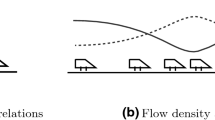Abstract
A nonlinear mathematical model, which takes into account the dissipative mechanism, is used to describe the signal transmission in a traffic flow. It is shown that dissipative mechanisms, under certain conditions, may produce attenuation effects against the typical nonlinear steepening of waves. An asymptotic analysis is carried out to discuss wave features when the governing hyperbolic system of equations is objective to different kinds of approximations.
Similar content being viewed by others
References
M. J. Lighthill and G. B. Whitham, Proc. Roy. Soc. Lond. A.229, 281–345 (1955).
P. I. Richards, Oper. Res.4, 43–51 (1956).
H. Grenberg, Oper. Res.7, 79–85 (1959).
F. A. Haight,Mathematical Theory of Traffic Flow. Academic Press, New York 1963.
G. B. Whitham,Linear and Nonlinear Waves. Wiley, New York 1974.
B. R. Seymour and E. Varley, Proc. Roy. Soc. Lond. A.314, 387–415 (1970).
D. Fusco, Mecania17, 128–137 (1982).
Author information
Authors and Affiliations
Rights and permissions
About this article
Cite this article
Sharma, V.D., Sharma, R.R., Pandey, B.D. et al. Non-linear analysis of a traffic flow. Z. angew. Math. Phys. 40, 828–837 (1989). https://doi.org/10.1007/BF00945805
Received:
Issue Date:
DOI: https://doi.org/10.1007/BF00945805




